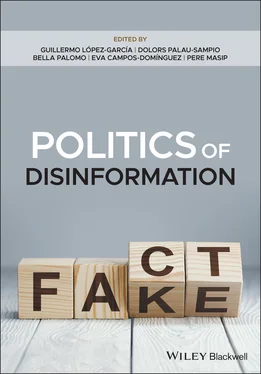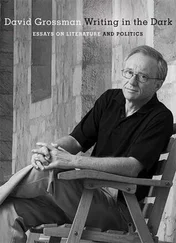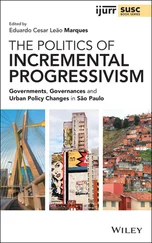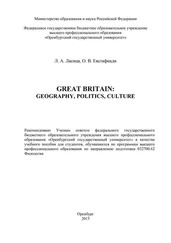Politics of Disinformation
Здесь есть возможность читать онлайн «Politics of Disinformation» — ознакомительный отрывок электронной книги совершенно бесплатно, а после прочтения отрывка купить полную версию. В некоторых случаях можно слушать аудио, скачать через торрент в формате fb2 и присутствует краткое содержание. Жанр: unrecognised, на английском языке. Описание произведения, (предисловие) а так же отзывы посетителей доступны на портале библиотеки ЛибКат.
- Название:Politics of Disinformation
- Автор:
- Жанр:
- Год:неизвестен
- ISBN:нет данных
- Рейтинг книги:5 / 5. Голосов: 1
-
Избранное:Добавить в избранное
- Отзывы:
-
Ваша оценка:
- 100
- 1
- 2
- 3
- 4
- 5
Politics of Disinformation: краткое содержание, описание и аннотация
Предлагаем к чтению аннотацию, описание, краткое содержание или предисловие (зависит от того, что написал сам автор книги «Politics of Disinformation»). Если вы не нашли необходимую информацию о книге — напишите в комментариях, мы постараемся отыскать её.
Discover a comprehensive exploration of the underlying theories of disinformation, and their impact, from leading voices in the field Politics of Disinformation
Politics of Disinformation
Politics of Disinformation — читать онлайн ознакомительный отрывок
Ниже представлен текст книги, разбитый по страницам. Система сохранения места последней прочитанной страницы, позволяет с удобством читать онлайн бесплатно книгу «Politics of Disinformation», без необходимости каждый раз заново искать на чём Вы остановились. Поставьте закладку, и сможете в любой момент перейти на страницу, на которой закончили чтение.
Интервал:
Закладка:
Part II, Disinformation in Politics , focuses on recent international cases of disinformation in political campaigns. Rose Marie Santini, Giulia Tucci, Débora Salles and Alda Rosana D. de Almeida analyze the role of instant messaging services that enable disinformation to be spread during elections, in “Do You Believe in Fake After All? WhatsApp Disinformation Campaign During the 2018 Brazilian Presidential Election” ( Chapter 4). Masduki, in Chapter 5, “The Politics of Disinformation in Indonesia (2014–2019),” examines the growth of disinformation practices in developing democracies, such as Indonesia, and the detrimental effects of fake news, hoaxes, and misleading information in election years. The next chapter, “Ideology and Disinformation: How False News Stories Contributed to Brexit” ( Chapter 6), by Imke Henkel, offers an insight into how British newspapers, notably the tabloid press, filled their pages with hostility toward European institutions for decades and influenced public opinion on Brexit. Lorena Cano-Orón, Germán Llorca-Abad and Guillermo López-García close this part of the book with Chapter 7, “Spanish Politicians Dealing with Fake News in the April 2019 General Election,” aiming to detect the creation and spread of fake news on Twitter by Spanish political parties during the April 2019 general election campaign.
Part III, Fact-checking in Politics , emphasizes the role of several initiatives that have been implemented to combat disinformation. Dolors Palau-Sampio and Adolfo Carratalá compare three fact-checking projects in “Checking Verifications: Focus and Scope of Collaborative Projects to Monitor Election Campaigns in France, Brazil, and Spain” (Chapter 8), to delve into the aims and limitations that they present. Tomás Dodds, in “Structures of Resistance: Citizen-generated Reporting in Times of Social Unrest” ( Chapter 9), examines the practices that emerged from civil society to fight against disinformation and fake news in Chile during the so-called October Revolution, the waves of antigovernment protests and cultural manifestations across the country. Eva Campos-Domínguez, Cristina Renedo Farpón, Dafne Calvo, and María Díez-Garrido focus on automated verification to discover how political parties and fact-checking organizations in Spain deal with disinformation during electoral campaigns and the appropriateness of the adopted measures in “Robot Strategies for Combating Disinformation in Election Campaigns: A Fact-checking Response from Parties and Organizations” ( Chapter 10). The last chapter of this part of the book, “‘That Prodigious Machinery Designed to Exclude’: The Discourse of Post-truth in Algorithmic Culture” (Chapter 11), by Jakub Nowak, offers a theoretical approach to the post-truth phenomenon as being inherently tied to how digital public spheres work, by tracking its connections with the transformation of media markets and changing patterns of news distribution.
Finally, Part IV, The Effects of Disinformation on Everyday Life , includes three chapters that address different perspectives on exposure to disinformation. In “Teens, Social Media, and Fake News: A User’s Perspective” ( Chapter 12), Heidi Mercenier, Victor Wiard and Marie Dufrasne analyze how teenagers receive, perceive, and interact with fake news on social media, drawing on focus groups composed of high-school students. Carlos Rodríguez-Pérez and Gustavo R. García-Vargas, in “Understanding Which Factors Promote Exposure to Online Disinformation” ( Chapter 13), examine the conditions under which citizens are more resilient or more likely to be associated with exposure to and concern about online disinformation in four Latin-American countries and 17 Western democracies. The final chapter, “Rumoring, Disinformation, and Contentious Politics in the Digital Age: The Case of China and Beyond” ( Chapter 14) by Jun Liu, presents an alternative understanding of rumor as disinformation, focusing on contentious politics in an authoritarian context like the People’s Republic of China.
This book is dedicated to one of its co-editors, Professor Dr Pere Masip, who passed away on July 18, 2021. Pere was an inspiring teacher and a rigorous researcher with vast knowledge; he had an insatiable intellectual curiosity that emerged from his wide-ranging education in archaeology, documentation, and journalism. His thoroughness, search for excellence, enormous capacity for work, and passion for research allowed him to easily lead projects and build cross-border networks and initiatives, which came together through digital journalism. His skills forged a professional reputation that has left an enduring legacy at his university and were surpassed only by his human qualities and enormous generosity with colleagues and students, because Pere Masip was one of those people who made this world better.
For us, the other co-editors of this book, the death of our colleague Pere has been a tremendous and unexpected shock because, despite the seriousness of his illness, we had been affected by his optimism for recovery; he threw himself into his academic work with enthusiasm and commitment until the end. He had suggested we create this book—a project about which he was enormously excited—after attending the 2019 IAMCR pre-conference in Valencia, “Disinformation and Political Processes: Media Strategies and Audience Attitudes,” which also arose from his inexhaustible energy and generosity. It has been a joy and a privilege to know, learn from, work, and live with Professor Pere Masip; his premature passing has affected us all. His memory will endure in his work, in all the many people who knew him, and in our hearts.
Pere, thank you for your help, and for inspiring and guiding us for so many years.
Acknowledgements
The editors want to remember that this book is a result of the International Association for Media and Communication Research (IAMCR) pre-conference entitled “Disinformation and political processes: media strategies and audience attitudes,” held by the University of Valencia in June 2019. We also want to thank the IAMCR for its support and several Spanish institutions for their financial aid, such as the Junta de Andalucía (SEJ612 - “MEDIO: Media & Data Innovation”), Generalitat Valenciana (AICO2020/224 - “Ecology of Disinformation”) and the Ministry of Science of Spain (refs. CSO-2016-81882REDT - “Excellence Network: Digital Journalism”; PID2019-108956RB100 - “The Impact of Disinformation in Journalism: Contents, Professional Routines and Audiences”; PID2020-113574RB-I00: “Disinformation flows, polarization and crisis of media intermediation”; RTI2018-095775-BC44).
References
1 Allcott, H.and Gentzkow, M.(2017). Social media and fake news in the 2016 election. Journal of Economic Perspectives 31 (2): 211–236.
2 Chadwick, A.(2017). The Hybrid Media System: Politics and Power. New York: Oxford University Press.
3 Flynn, D.J., Nyhan, B., and Reifler, J.(2017). The nature and origins of misperceptions: understanding false and unsupported beliefs about politics. Political Psychology 38: 127–150.
4 Gottfried, J.and Shearer, E.(2017). Americans’ online news use is closing in on TV news use. Pew Research Center, 7.
5 Horta Ribeiro, M., Calais, P.H., Almeida, V.A., and Meira Jr., W.(2017). Everything I disagree with is #fakenews”: correlating political polarization and spread of misinformation. DS+J’17, Halifax.
6 Lewandowsky, S., Ecker, U.K., and Cook, J.(2017). Beyond misinformation: understanding and coping with the “post-truth” era. Journal of Applied Research in Memory and Cognition 6 (4): 353–369.
7 Spence, P.R., Lachlan, K.A., Edwards, A., and Edwards, C.(2016). Tweeting fast matters, but only if I think about it: information updates on social media. Communication Quarterly 64 (1): 55–71.
Читать дальшеИнтервал:
Закладка:
Похожие книги на «Politics of Disinformation»
Представляем Вашему вниманию похожие книги на «Politics of Disinformation» списком для выбора. Мы отобрали схожую по названию и смыслу литературу в надежде предоставить читателям больше вариантов отыскать новые, интересные, ещё непрочитанные произведения.
Обсуждение, отзывы о книге «Politics of Disinformation» и просто собственные мнения читателей. Оставьте ваши комментарии, напишите, что Вы думаете о произведении, его смысле или главных героях. Укажите что конкретно понравилось, а что нет, и почему Вы так считаете.












